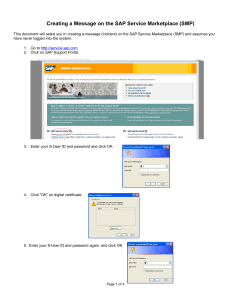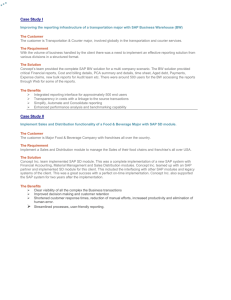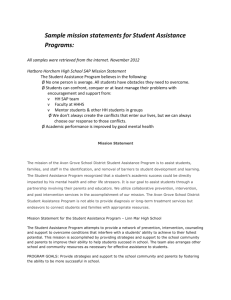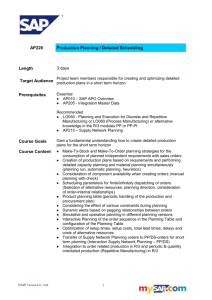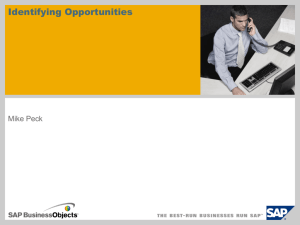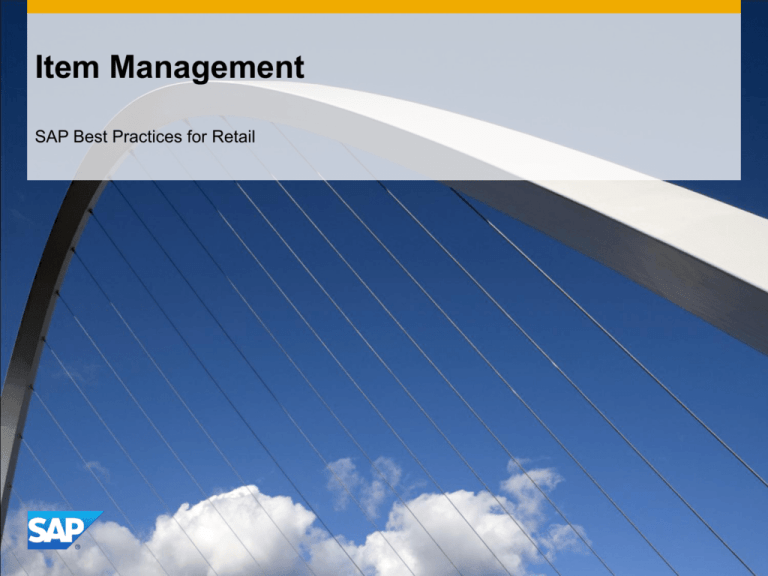
Item Management
SAP Best Practices for Retail
Purpose, Benefits, and Key Process Steps
Purpose
Within the scenario Item Management, Article creation of single, Generic and structured articles
will be displayed in the process for article maintenance. This scenario also addresses the
principal features of maintaining articles, creating listing conditions using integrated article
maintenance and also at reference handling in the article master.
Benefits
Manage all business related master data
Efficient, consistent master data handling incl. mass data handling and high integration
Efficient discontinuation of item data
Key Process Steps
Create and process a single article
Create and process a generic article
Create and process a prepack
Create and process a sales set
Create and process a display
© 2011 SAP AG. All rights reserved.
2
Required SAP Applications and Company Roles
Required SAP Applications
SAP SAP enhancement package 5 for SAP ERP 6.0
Company Roles
Retail Master Data Manager
Retail Assortment Planner
Retail Pricing Manager
Retail Non – Seasonal Purchaser
Retail Warehouse Specialist
© 2011 SAP AG. All rights reserved.
3
Process Flow Diagram
Item Management
Implement
Listing
Maintain
Logistics Data
for All DCs /
Stores
Retail Assortment
ECC Planner
Retail Master Data Specialist
Create Single
Article
(Manually)
© 2011 SAP AG. All rights reserved.
Display a
Generated
Assortment
Module
Create a
maintenance
group
Extension of a
maintenance
group by a
template
Create Core
Master Article
with Template
Check the
Article
Creation
Mass
Maintenance
using
Reference
Sites
Check the
Article
Creation for
the Copied
Article
Article copy to
create a new
Article
Mass
Maintenance
using the
Article Monitor
Alternative
Data
Maintenance
(Alternative
Organizational
Levels)
Mass
Maintenance
Using Mass
Maintenance
Tools
Article
Discontinuatio
n
Create Article
List
Follow up and
Replacement
Articles
Store
Characteristic
Values
Characteristic
Value
Grouping
Reference
Handling for
Generic Article
Variants
Process the
Generic Article
Create a
Generic Article
with Variants
Assign the
Characteristic
Profile to a
Merchandise
Category
Create a
Characteristic
Profile with
the new
Characteristic
s
Price Matrix
for Variants of
Generic
Articles
Matrix
Handling for
Master Data
Fields for the
Generic Article
Create
Prepack
Process
Prepack
Display the
Profile Module
for Store M001
using
Assortment
Menu
4
Process Flow Diagram
Determine
valuation prices
for prepack
components
Goods receipt
without
references
Create a Sales
Set
Department
Store/Shop
Concept
Create display
Process a Sales
Set
Retail Warehouse
Specialist
Retail Masterdata
Specialist
Retail Pricing
Manager/Specialist
Item Management - continued
© 2011 SAP AG. All rights reserved.
Process display
Goods Receipt
without
references
Set up
structured
article
Create supply
relationship
Price level
groups
Goods Receipt
without
references
Direct store
delivery
Create
Purchase order
5
Article Creation
© 2011 SAP AG. All rights reserved.
6
Article Maintenance/ Listing: Types of Article
The relevant types of articles for Retail are:
Single
article
Case set
=
Sales set
Generic
article
© 2011 SAP AG. All rights reserved.
Groups of
articles
with special
sales price
Shoe-Prepack
=
Prepack
Amount arrangement
of the variants
of an article
Sockes
=
Display
article
combined
with an
particular
packing
7
Generic Article/Variants
Variants - Article, which are only different in particular
characteristics (e.g. colour, value )
Variants of the articles are combined under a generic article
Own master record for every inventory-managed variant
Generic article
© 2011 SAP AG. All rights reserved.
Variants
8
Creation of a Generic Article in SAP Retail
Definition merchandize category
Assignment of char./profile char. of the material group
Qualifier of the char. as variants-forming
Creation of an article with art. category generic article to merch. cat
Selection of the relevant variants in matrix
© 2011 SAP AG. All rights reserved.
9
Sales-Set
DC
Vendor
Store
Consumer
Case, ca. 77/54/25 cm, black-brown
89.90
+
Case, ca. 69/46/24 cm, black-brown
59.90
+
Set: Case and travelling bag
threepart case-set
169.90
Travelling bag, ca. 63/32/29 cm. blackbrown
39.90
Constitution of the sales sets with articles of
different material groups is possible
standard sales price only in the store
Component = independent article
© 2011 SAP AG. All rights reserved.
10
Display
Vendor
DC
Store
consumer
Display consists of a header article and the components
Components = independent article
© 2011 SAP AG. All rights reserved.
11
Prepack
Vendor
DC
Store
5 Pieces
5 Pieces
10 Pieces
10 Pieces
10 Pieces
5 Pieces
5 Pieces
Consume
r
x size 36
x size 37
x size 38
x size 39
x size 40
x size 41
x size 42
All Components of the prepack are variants of a
generic article -> same material group
Vendor allows information about components
Point of the cancellation (referring to the stock) of the prepack
adjustable
© 2011 SAP AG. All rights reserved.
12
Inventory Management: Structured - Generic Article
Structured material in logistic procedure
Objekt
Lieferant
DC
Site
Prepack
Display
Price-/ SalesSet
Generic article
-> variants
Inventory Management
Alternative
Inventory Management
© 2011 SAP AG. All rights reserved.
13
Reference Handling
© 2011 SAP AG. All rights reserved.
14
Reference Article
Merchandize
category
generic article
Explicit
reference article
gives reference data for
Refsite
Article
New Article
Creation
© 2011 SAP AG. All rights reserved.
15
Generic Article
Merchandize category
reference article
Explicit
reference article
gives reference data for
Article
Article
© 2011 SAP AG. All rights reserved.
Generic
article
Variants
Changes
copy
16
Reference Data
Reference article (merchandize category, reference article, explicit reference article)
Regular
Vendor
Season
Master Data
Purchasingdata
General. Listing
data
Log. data
Refsite
Listing data
distribution
channel
Sales-data
POS Data
Log. data
other site
Customizing / Constants
Copy of changes
Reference data only by generation
© 2011 SAP AG. All rights reserved.
17
Listing
© 2011 SAP AG. All rights reserved.
18
Listing Procedure
Process to assign an article to a general assortment of a store
or a distribution center via assortment module
By the listing you define whether and when the article can be
ordered, delivered and sold.
© 2011 SAP AG. All rights reserved.
19
Assortment Objects
Assortmentmodule
Assortment
DC
South-West
DC South-West
Article
Assortmentmodule
Assortment
StoreLondon
Store London
Assortmentmodule
Assortmentmodule
Assortment module
© 2011 SAP AG. All rights reserved.
General
assortment 1
General
assortment 2
Customer
20
Assortment Description
Store
DC
Customer
(General) Assortment
Article
IDoc
Listing conditions
Listing
process
Promotion
Assignment table
Manual Modules
Assortment function
© 2011 SAP AG. All rights reserved.
21
Assortment Level Rules
Store London
Store Manchester
Assortment-level
Deluxe-Assortment
Special-Assortment
Store Nottingham
Store Bath
Advanced Assortment
Base-Assortment
House type / Customer type
© 2011 SAP AG. All rights reserved.
22
Process of the Classification Rule Check
Material group blouses
Site
attribute:
Style
"*" (all)
Store London
Article
attribute:
Style
© 2011 SAP AG. All rights reserved.
fashionable
modish
classic
Store Manchester
Store Bath
classic
23
Listing Procedure: Process of the Layout Check
Store Manchester
Store London
Layout modules
Cooling
bar
Drinks
.....
Article
© 2011 SAP AG. All rights reserved.
24
Direct Store Delivery (DSD)
© 2011 SAP AG. All rights reserved.
25
Direct Store Delivery: Supply Network
© 2011 SAP AG. All rights reserved.
26
Direct Store Delivery (DSD) features
One application with single point of entry to collect some existing master data
maintenance transactions
An intuitive, user-friendly decision cockpit for the category manager to review related
master data (e.g. prices) for category optimization
Using a data model to store the supply relationship related master data (distributorstore-item relationships; store specific purchasing, sales and promotion prices)
Drag- and drop functionality to create/change supply relationships between vendorstore-article
Allow multiple vendors per article and store
Selection function for main vendor relationships
Change of main vendor per article via an additional maintenance screen
Termination of supply relationships within the workbench
Automatic update of info records (article-vendor)
Mass maintenance User Interface (UI) for the category manager to create and change
the supply relationships
Sales price calculation with list display on a vendor-store level (also mass-update
functionality)
© 2011 SAP AG. All rights reserved.
27
© 2011 SAP AG. All rights reserved
No part of this publication may be reproduced or transmitted in any form or for any purpose
without the express permission of SAP AG. The information contained herein may be
changed without prior notice.
Some software products marketed by SAP AG and its distributors contain proprietary
software components of other software vendors.
Microsoft, Windows, Excel, Outlook, and PowerPoint are registered trademarks of Microsoft
Corporation.
IBM, DB2, DB2 Universal Database, System i, System i5, System p, System p5, System x,
System z, System z10, System z9, z10, z9, iSeries, pSeries, xSeries, zSeries, eServer,
z/VM, z/OS, i5/OS, S/390, OS/390, OS/400, AS/400, S/390 Parallel Enterprise Server,
PowerVM, Power Architecture, POWER6+, POWER6, POWER5+, POWER5, POWER,
OpenPower, PowerPC, BatchPipes, BladeCenter, System Storage, GPFS, HACMP,
RETAIN, DB2 Connect, RACF, Redbooks, OS/2, Parallel Sysplex, MVS/ESA, AIX,
Intelligent Miner, WebSphere, Netfinity, Tivoli and Informix are trademarks or registered
trademarks of IBM Corporation.
Linux is the registered trademark of Linus Torvalds in the U.S. and other countries.
Adobe, the Adobe logo, Acrobat, PostScript, and Reader are either trademarks or
registered trademarks of Adobe Systems Incorporated in the United States and/or other
countries.
Oracle is a registered trademark of Oracle Corporation.
UNIX, X/Open, OSF/1, and Motif are registered trademarks of the Open Group.
Citrix, ICA, Program Neighborhood, MetaFrame, WinFrame, VideoFrame, and MultiWin are
trademarks or registered trademarks of Citrix Systems, Inc.
HTML, XML, XHTML and W3C are trademarks or registered trademarks of W3C®, World
Wide Web Consortium, Massachusetts Institute of Technology.
Java is a registered trademark of Sun Microsystems, Inc.
JavaScript is a registered trademark of Sun Microsystems, Inc., used under license for
technology invented and implemented by Netscape.
Business Objects and the Business Objects logo, BusinessObjects, Crystal Reports, Crystal
Decisions, Web Intelligence, Xcelsius, and other Business Objects products and services
mentioned herein as well as their respective logos are trademarks or registered trademarks
of Business Objects Software Ltd. Business Objects is an SAP company.
Sybase and Adaptive Server, iAnywhere, Sybase 365, SQL Anywhere, and other Sybase
products and services mentioned herein as well as their respective logos are trademarks or
registered trademarks of Sybase, Inc. Sybase is an SAP company.
All other product and service names mentioned are the trademarks of their respective
companies. Data contained in this document serves informational purposes only. National
product specifications may vary.
The information in this document is proprietary to SAP. No part of this document may be
reproduced, copied, or transmitted in any form or for any purpose without the express prior
written permission of SAP AG.
This document is a preliminary version and not subject to your license agreement or any
other agreement with SAP. This document contains only intended strategies, developments,
and functionalities of the SAP® product and is not intended to be binding upon SAP to any
particular course of business, product strategy, and/or development. Please note that this
document is subject to change and may be changed by SAP at any time without notice.
SAP assumes no responsibility for errors or omissions in this document. SAP does not
warrant the accuracy or completeness of the information, text, graphics, links, or other items
contained within this material. This document is provided without a warranty of any kind,
either express or implied, including but not limited to the implied warranties of
merchantability, fitness for a particular purpose, or non-infringement.
SAP shall have no liability for damages of any kind including without limitation direct,
special, indirect, or consequential damages that may result from the use of these materials.
This limitation shall not apply in cases of intent or gross negligence.
The statutory liability for personal injury and defective products is not affected. SAP has no
control over the information that you may access through the use of hot links contained in
these materials and does not endorse your use of third-party Web pages nor provide any
warranty whatsoever relating to third-party Web pages.
SAP, R/3, SAP NetWeaver, Duet, PartnerEdge, ByDesign, SAP BusinessObjects Explorer,
StreamWork, and other SAP products and services mentioned herein as well as their
respective logos are trademarks or registered trademarks of SAP AG in Germany and other
countries.
© 2011 SAP AG. All rights reserved.
28



